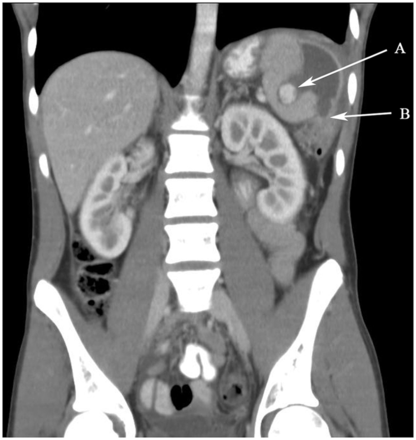Tip of the hat to John Greenwood, who got the correct answer to this problem case. The CT shows that the patient developed a pseudoaneurysm in the spleen (A) with a fistula to the splenic flexure of the colon (B). This resulted in a sentinel bleed that caused an episode of hematochezia.

Could this have been detected at the initial presentation? No, since the pseudoaneurysm was not seen on the initial CT. There is little support in the literature for serial evaluation by CT, but this may be the one case (in a billion!) where it may have been useful. This should not be enough to change your ordering behavior, though.
How does the pseudoaneurysm result in a fistula to the colon? That’s a good question. Pseudoaneurysms typically grow until they rupture, resulting in troublesome bleeding. My suspicion was that there was also a colon injury at the splenic flexure due to the handlebar injury mechanism which allowed this process to develop. Otherwise it’s hard to envision a pseudoaneurysm burrowing through all layers of a normal colon for no real reason.
What’s the proper treatment? In my mind, only exploration with splenectomy and colon resection/repair is acceptable. Embolization of the spleen may reduce the likelihood of future bleeding, but there is still a potential abscess in the area and it’s very difficult to predict what it will do over time.
Reference: Splenocolic fistula after nonoperative management of splenic rupture. Trauma 15(1):86-90, 2013.

